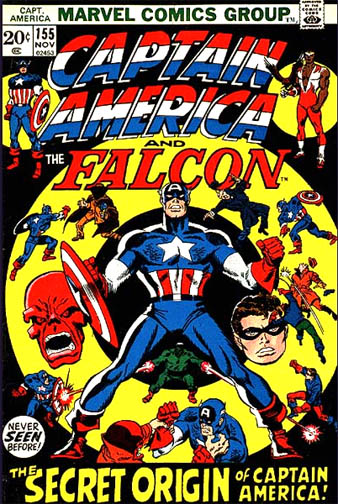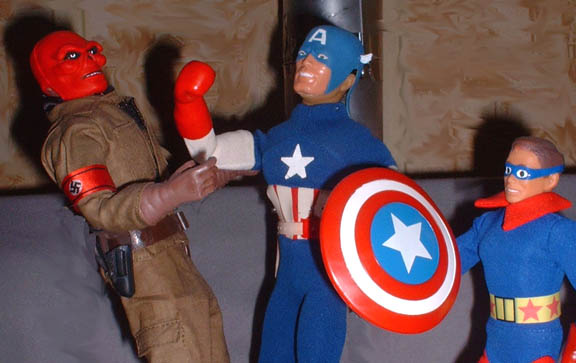 With all the recent hoopla about Marvel killing off Captain America (like they won’t revive him in another year or two), I got to thinking about my very first Captain America comic. It was Captain America #155, which also featured his then partner The Falcon. I didn't know at the that this issue was part of a very special story arc in the Captain’s Bronze Age history.
With all the recent hoopla about Marvel killing off Captain America (like they won’t revive him in another year or two), I got to thinking about my very first Captain America comic. It was Captain America #155, which also featured his then partner The Falcon. I didn't know at the that this issue was part of a very special story arc in the Captain’s Bronze Age history.
You see, Steve Englehart had taken over the writing duties for Captain America a few issues earlier, and his first assignment was to figure out a way to explain those Captain America comics that had come out during the 50s. According to Stan Lee’s revised history, Captain America had been put in suspended animation shortly before the end of World War II and revived in the 60s. However, comic fans knew that Captain America had also appeared in several issues of Young Men comics in the 50s. Who was that guy if Cap was on ice at the time? Mr. Englehart explained that another man and his teenaged student were transformed into a new Captain America and Bucky to fight the Communist menace. They were later put into suspended animation in the mid-50s, but then revived in the 70s and these two were giving the real Cap a bad reputation. The real Captain America, a.k.a. Steve Rogers, puts this bogus Captain America out of action, but the bad guy was brought back once again as The Grand Director. It’s all very complicated, so let’s get back to my seven-year-old mind and Issue #155 and the summer of 1972.
 I think I grabbed this issue off the spinner rack because of the unusual cover. Instead of a standard picture of Cap beating up a bad guy, #155 had this abstract, “bullseye” design with Captain America in the center and all kinds of little things going on in the corners. Another interesting feature was that it proclaimed to reveal “The Secret Origin of Captain America.” Pretty nice way to start off your virgin reading experience with a new superhero! In fact, the flashback section of the book where Steve Rogers is injected with the super strength serum looked just like the old Jack Kirby/Joe Simon artwork. Since I’m writing from memory, I’m not sure whether it was the real artwork or an artist mimicking the style, but either way, the effect of changing styles back and forth to suggest a different era was fascinating to me. I was beginning to sense how comic books had a history and a continuity.
I think I grabbed this issue off the spinner rack because of the unusual cover. Instead of a standard picture of Cap beating up a bad guy, #155 had this abstract, “bullseye” design with Captain America in the center and all kinds of little things going on in the corners. Another interesting feature was that it proclaimed to reveal “The Secret Origin of Captain America.” Pretty nice way to start off your virgin reading experience with a new superhero! In fact, the flashback section of the book where Steve Rogers is injected with the super strength serum looked just like the old Jack Kirby/Joe Simon artwork. Since I’m writing from memory, I’m not sure whether it was the real artwork or an artist mimicking the style, but either way, the effect of changing styles back and forth to suggest a different era was fascinating to me. I was beginning to sense how comic books had a history and a continuity.
 This became one of my favorite comic books of that summer (I was reading quite a few during those sultry months), and I re-read the book several times. I always associate that comic with the Summer Olympics in Munich, Germany. Although the games officially ran from August 26th to September 11th, they seemed to go on forever. I remember perusing my Captain America comic when Mark Spitz was racking up his seven swimming gold medals, or studying that cool flashback segment when Olga Korbut was showing that some Russian women could be cute and perky. I also remember reading Issue #155 when it was announced that eight Palestinian terrorists had taken 11 Israeli athletes hostage, killing two in their apartment right away.
This became one of my favorite comic books of that summer (I was reading quite a few during those sultry months), and I re-read the book several times. I always associate that comic with the Summer Olympics in Munich, Germany. Although the games officially ran from August 26th to September 11th, they seemed to go on forever. I remember perusing my Captain America comic when Mark Spitz was racking up his seven swimming gold medals, or studying that cool flashback segment when Olga Korbut was showing that some Russian women could be cute and perky. I also remember reading Issue #155 when it was announced that eight Palestinian terrorists had taken 11 Israeli athletes hostage, killing two in their apartment right away.
 I didn’t know anything about the Israeli-Palestinian conflict at that time, and I still didn’t understand it after the hostage situation ended in a bloody massacre. All I knew was that the Olympic Games were supposed to be about friendly competition amongst the world’s best athletes. There was no place for such brutality at a fun event like this. I equated the terrorists with the bullies at school who would interrupt a friendly game by pushing kids around and starting trouble. That was kid’s stuff, though, and I was consoled with the notion that things got better when you grew up. After those Summer Olympics, I knew that some people never lost their need to inflict violence and mayhem no matter how many more people desired peace. When I saw a shaken Jim McKay solemnly report that "they're all gone,” I was assured that things never really got better.
I didn’t know anything about the Israeli-Palestinian conflict at that time, and I still didn’t understand it after the hostage situation ended in a bloody massacre. All I knew was that the Olympic Games were supposed to be about friendly competition amongst the world’s best athletes. There was no place for such brutality at a fun event like this. I equated the terrorists with the bullies at school who would interrupt a friendly game by pushing kids around and starting trouble. That was kid’s stuff, though, and I was consoled with the notion that things got better when you grew up. After those Summer Olympics, I knew that some people never lost their need to inflict violence and mayhem no matter how many more people desired peace. When I saw a shaken Jim McKay solemnly report that "they're all gone,” I was assured that things never really got better.
I could falsely concoct some story that I had secretly wished for Captain America to come and save the hostages, but no such thought occurred to me. Like most normal seven-year-olds, I knew the Captain was a fantasy created to fulfill our collective yearning for swift justice. I knew superheroes were not real and never could be. The only connection I made was that comic books were more fun than real life, and I retreated into comics for most of my young life. I even re-read my Issue #155 on Labor Day while Jerry Lewis, strung out on Percodan, was chastising me for not sending in money for his “kids.” Just like the Captain’s arch enemy Red Skull, that greasy-haired man in the tuxedo was repulsive and fascinating at the same time.
 With all the recent hoopla about Marvel killing off Captain
With all the recent hoopla about Marvel killing off Captain  I think I grabbed this issue off the spinner rack because of the unusual cover. Instead of a standard picture of Cap beating up a bad guy, #155 had this abstract, “bullseye” design with Captain
I think I grabbed this issue off the spinner rack because of the unusual cover. Instead of a standard picture of Cap beating up a bad guy, #155 had this abstract, “bullseye” design with Captain  This became one of my favorite comic books of that summer (I was reading quite a few during those sultry months), and I re-read the book several times. I always associate that comic with the Summer Olympics in
This became one of my favorite comic books of that summer (I was reading quite a few during those sultry months), and I re-read the book several times. I always associate that comic with the Summer Olympics in  I didn’t know anything about the Israeli-Palestinian conflict at that time, and I still didn’t understand it after the hostage situation ended in a bloody massacre. All I knew was that the Olympic Games were supposed to be about friendly competition amongst the world’s best athletes. There was no place for such brutality at a fun event like this. I equated the terrorists with the bullies at school who would interrupt a friendly game by pushing kids around and starting trouble. That was kid’s stuff, though, and I was consoled with the notion that things got better when you grew up. After those Summer Olympics, I knew that some people never lost their need to inflict violence and mayhem no matter how many more people desired peace. When I saw a shaken Jim McKay solemnly report that "they're all gone,” I was assured that things never really got better.
I didn’t know anything about the Israeli-Palestinian conflict at that time, and I still didn’t understand it after the hostage situation ended in a bloody massacre. All I knew was that the Olympic Games were supposed to be about friendly competition amongst the world’s best athletes. There was no place for such brutality at a fun event like this. I equated the terrorists with the bullies at school who would interrupt a friendly game by pushing kids around and starting trouble. That was kid’s stuff, though, and I was consoled with the notion that things got better when you grew up. After those Summer Olympics, I knew that some people never lost their need to inflict violence and mayhem no matter how many more people desired peace. When I saw a shaken Jim McKay solemnly report that "they're all gone,” I was assured that things never really got better.



No comments:
Post a Comment